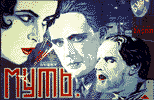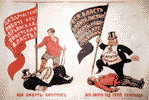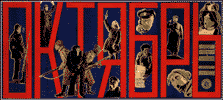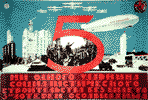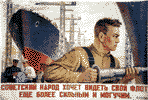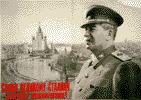|
|
 russian & soviet poster history
The Soviet art of propaganda falls into six main periods: The Bolshevik Era (1917-1921) was a time of life-and-death struggle for the Bolshevik ideology. Helping to fight enemies within and without, the early Soviet poster was remarkable for its revolutionary fervor and powerful symbolism. [View Bolshevik Posters] [more text] The New Economic Policy (1921-1927) was a period of recovery and relative freedom for a country ravaged by war, famine and bitter discontent. The commercial and film posters of Russia's "Roaring Twenties" were remarkable for their avant-garde Constructivist style. [View NEP Posters] [more text] The First and Second Five Year Plans (1928-1937) were Stalin’s draconian push to convert Russia into a fully communist industrialized power. The great photomontage posters of the First Five Year plan echoed the heroic side of this effort, only to be followed by the purges of the late ‘30s and the retreat from avant-garde art in the Second Plan period. [View Five Year Plan Posters] [more text] The Great Patriotic War (1939-1945) saw a revival of the great age of the Bolshevik poster. The Soviet struggle for survival forced a return to symbolism that fanned the patriotic fires of the heartland. [View Great Patriotic War Posters] [more text] The Cold War (1946-1984) brought a return to "Social Realism," with utopian views of Russia and Joseph Stalin predominating. In its middle years, the best images featured Vietnam and the space race. As perestroika (1984-present) dawned, the most powerful images were protest posters created and posted at great personal risk. [View Cold War Posters] [more text] |
 Moor, Dimitri 1st of May - A Festival of Labor |
|
| Collecting Soviet Posters | |
|
Soviet posters are a relatively new area of collecting. Virtually unavailable in the West until perestroika, they were thoroughly researched by Stephen White in his 1988 monograph The Bolshevik Poster. With the decline of communism, there is more interest than ever in the images from this bold social experiment. Although most Soviet posters were issued in editions of 5,000 to 50,000, they are extremely rare today. The primary reason is that most posters--as intended--were posted, and survived only weeks or months. The remainder were generally not recognized as valuable historical documents or collectibles at the time they were printed. They usually were recycled or lost due to the ravages of war or neglect. Others were destroyed for political reasons; it was dangerous to keep images of Trotsky after 1928, for example. The mid-1980s saw a steady trickle of images out of Russia, but that trickle has slowed, and many of the highest quality pieces are already unavailable. The works of Rodchenko, Lissitsky and Klutsis can range from $10,000 to $100,000, but many museum caliber pieces from before World War II are available at $300 to $1500. The Bolshevik period is a particularly rich one for collecting. Less expensive, but still fascinating and valuable post-WWII images are also available. [top] |
|
| The Bolshevik Era (1917-1921) [View Posters] | |
|
|
The Bolshevik Revolution created the world's first Communist state. The poster played a key role in selling Lenin’s vision of total cultural and political transformation to a largely illiterate population: it was the centerpiece of the first modern propaganda machine. About 3,600 poster designs were created in roughly three years--more than 20 per week. The new government began by seizing control of the paper supply and all forms of printing. By mid-1918, it began to print and distribute posters. Alexander Apsit, the first great Bolshevik poster artist, developed many distinct Soviet symbols, such as the hammer and sickle and red star. Although his allegorical style was traditional, his imagery reflected the rhetoric of a new age. As Civil War intensified in 1919, the Bolsheviks set up a new Literary-Publishing Department to coordinate propaganda. Its major weapons were Dimitri Moor and Viktor Deni, both cartoonists before the Revolution. Moor was a fervent Communist, whose views had been formed during the unsuccessful Revolution of 1905. Moor’s symbolic early style changed with the tenor of the times. His most famous poster, Have You Enrolled as a Volunteer?, was produced in a single night as recruitment needs grew critical. About 50,000 copies of this poster were distributed, and its bold and simple image of a Red Army man inspired young men to sign up in droves. Deni was above all a satirist, and his scathing caricatures of fat capitalists and priests were omnipresent during Civil War years. Along with the dynamic Nikolai Kochergin, he and Moor maintained remarkably high standards despite severe time constraints. By 1920, this became even more difficult as war broke out with Poland and her allies. These years inspired another innovation in poster art: the Russian Telegraph Agency (ROSTA) windows, cartoon-like stenciled posters that summarized the news and were displayed in shop windows throughout Moscow. Created by the poet Vladimir Mayakovsky and the artists Mikhail Cheremnykh and Ivan Malyutin, the ROSTA windows are extraordinary in their rarity, wit and effectiveness. By mid-1920, the Bolsheviks had defeated the Whites and reached a stalemate with the Poles. This marked the end of the pioneering era in Bolshevik propaganda. [top] |
| The New Economic Policy (1921-1927) [View Posters] | |
|
|
By 1921, Russia was finally at peace, but the wars had brought almost total economic collapse, famine and bitter discontent. In desperation, Lenin introduced the New Economic Policy (NEP), which allowed some private enterprise to return. Small farms and businesses flourished, while the State kept control of heavy industry, transport and foreign trade. The NEP years were the "Roaring Twenties" of Russia. This relatively free period featured exciting experimentation in all fields. In the arts, the Constructivist movement dominated. Rejecting art for art’s sake, this group wanted to contribute to the "construction" of a new Communist society. The rallying cry "Art into Production" was led by the towering geniuses of El Lissitsky and Alexander Rodchenko. Their work with photomontage, photography, and graphic design had a major impact on the direction of Western graphic arts, particularly the Bauhaus school. One of the most remarkable developments was the teaming of Mayakovsky and Rodchenko as "advertising constructors" for state-run businesses. They developed an ‘agitational’ style of advertising in which strident slogans and aggressive compositions with strong diagonals and color became the peacetime equivalent of the revolutionary poster. The NEP years also brought the Soviet film industry to new heights. Thousands of cinemas were built and hundreds of films produced. Sovkino, the national film institute, funded the masterpieces of Eisenstein (Battleship Potemkin and October), Dovzhenko (Zvenigora); and Vertov. Their daring use of new techniques such as photomontage, double images, intercutting, split screens, and freeze frames had a major impact on Western film. The film posters of this period are as remarkable as the films they advertised. Indeed, they are considered the most imaginative and startling film posters ever conceived. Not only did they incorporate the experimental techniques used in the films, but because the movies were silent and plotlines were often changed to suit censors, the artists had enormous creative license. State poster production was headed by Yakov Ruklevsky, who recruited a remarkable group of design school graduates. Most famous were the Stenberg brothers, Georgii and Vladimir, whose dynamic images capture the chaotic spirit of the age. Others included Nikolai Prusakov, Iosif Gerasimovich, and the prolific Mikhail Dlugach who created more than 500 posters. [top] |
| The First Five Year Plan (1928-1932) [View Posters] | |
|
|
Upon assuming complete control in 1928, Stalin immediately put an end to the NEP and embarked on a new course to full communism with the Five Year Plan. Intended to turn the USSR rapidly into a powerful industrial nation, it called for vast production increases and massive construction throughout the country. The second aspect of the Plan was the destruction of private farming and the creation of collectives where the peasants worked for the State. After widespread resistance and brutal enforcement, the goals were achieved. By 1933, industry and agriculture were firmly under Stalin's control and the Plan was declared complete six months early. Mobilization was the theme of these years. In 1932, Stalin decreed that all art must conform to ‘Social Realism,’ which rigidly required ‘realistic’ portrayals of Soviet life and Communist values. Experiments in society ended, and all forms of expression were mobilized to serve the state. The Plan generated a mass of strictly controlled propaganda. Strident posters appeared everywhere, in factories, farms and all public spaces, in vast quantities and variety. The country was "on the attack": fulfill the plan, exceed quotas, defend the USSR. The master of this message was Gustav Klutsis (1895-1944), a Constructivist artist who transformed the techniques of the ‘20s into a visual glorification of the plan and the new society. His colors were simple--usually only red and black--but his photomontage composition was dynamic and astonishing, with novel proportions and perspectives, juxtaposed with bold typography--all designed to stress the monumental and heroic aspect of the age. Klutsis and others praised the shock-brigade workers, collective farmers, Young Communists and women workers, demanded contributions for the air fleet or road construction, and stressed the goal of the Plan and a classless socialist society. They attacked the enemies of the State both within and without, always portraying the Soviet Union as the champion of peace and social justice. [top] |
| The Second Five Year Plan (1933-1937) [View Posters] | |
|
|
After this frantic and heroic age, a second Five Year Plan was announced to start immediately. It essentially made up for the shortcomings in the first plan, especially in transport, and even offered some consumer goods, but these were rapidly subordinated to the need to rearm in face of the Nazi menace. The greatest effort, though, went into a different war -- one that was not advertised. Beginning in 1934, Stalin embarked on a thorough purge of the Party, then the army. Anyone remotely suspected of opposition or even lack of enthusiasm was exiled to the camps or shot. The slaughter claimed untold thousands and ended only as the real war approached. It included many artists of the early periods, such as Klutsis, who died in the gulags. Mayakovsky was an early victim, committing suicide in 1930 after his ostracism in political and artistic circles. More and more a single theme dominated. Literature, art and posters of this period overwhelmingly stressed the role of the infallible leader, Joseph Stalin. His image appeared everywhere, in every context, and always greater than life. The dead hand of conformity, backed by the all-pervading terror, drove out originality and spontaneity, producing the art of Social Realism that dominated the USSR long past the death of Stalin in 1953. [top] |
| "The Great PatrioticWar" (1941-1945) [View Posters] | |
|
|
The stylistic conformity of Social Realist posters of the late ‘30s ended abruptly with Hitler’s invasion in June 1941. The forces unleashed in the crisis days of the Civil War were reawakened, and Soviet artists again rose to the challenge. Indeed, some of the most powerful icons of the Civil War reappeared. The most famous was Moor’s Have you Enrolled as a Volunteer?, which resurfaced as How have you helped the Front? Mikhail Cheremnykh, creator of the ROSTA Windows during the dark days of the Civil War, issued the first "Tass Window" shortly after the invasion. Tass was the news agency which superseded ROSTA in 1925, and stenciled Tass Windows became a symbol of Soviet resolve throughout the struggle. The themes of Soviet propaganda shifted dramatically as the Nazi threat grew. Patriotic appeals began to overshadow the theme of communism and the class struggle. Speeches and posters were populated by references to great pre-Soviet heroes such as Alexander Nevsky (the conqueror of the Teutonic Knights who invaded Russia in 1242) and Suvorov, who defeated the Turks in 1787. Anti-religious themes disappeared, and satiric cartoons of Kulaks and Capitalists gave way to vicious attacks on Hitler and his henchmen. The Soviet leadership realized that to survive, it needed any help it could find -- both in and out of the country. Due to Stalin’s purges, the majority of posters were produced by younger artists, and many of these revealed a stylistic shift toward realism. Best among these artists were the Kukryniksky, a student triumvirate from Vkhutemas, who worked as cartoonists, illustrators and posterists. Irakly Toidze, artist of the The Motherland-Mother Calls, Viktor Koretsky, and Viktor Ivanov, all born after 1900, created some of the best posters of the war. [top] |
| Post-World War II (1946-Present) [View Posters] | |
|
|
The Post-War period was marked by a return to Social Realism, with Stalin once again becoming the focus of most posters. The High Stalinist Period (1946-1953) revealed images of utopian harmony. Revolutionary fervor returned in the '60s, fanned by the Cold War and the Space Race, and this was reflected in more heroic and satirical images. As perestroika (1984-present) neared, protest became a dominant and powerful poster theme. [top] |
| Copyright 1998 Jim Lapides and Clive Foss |
| PosterShow.com 205 Newbury Street Boston, Massachusetts 02116 |
voice:
(617) 375-0076 fax: (617) 375-0079 email: sales@internationalposter.com |
Copyright 2003 PosterShow
